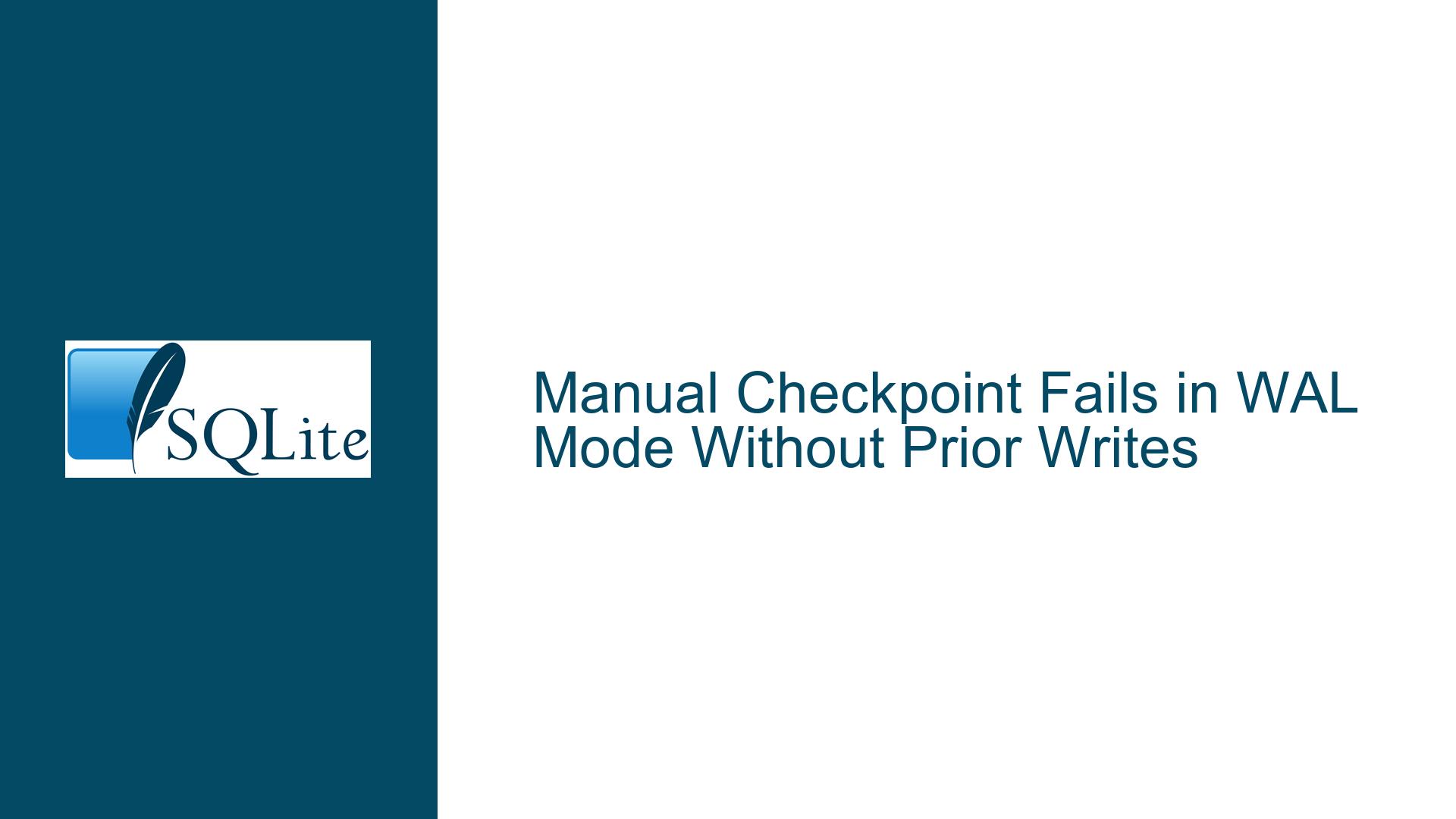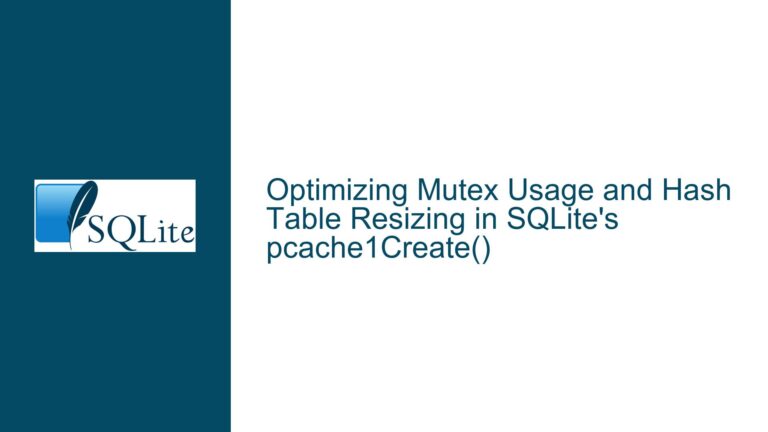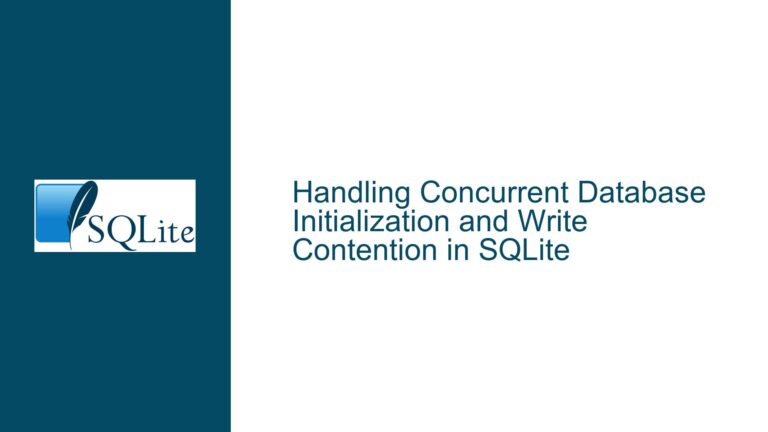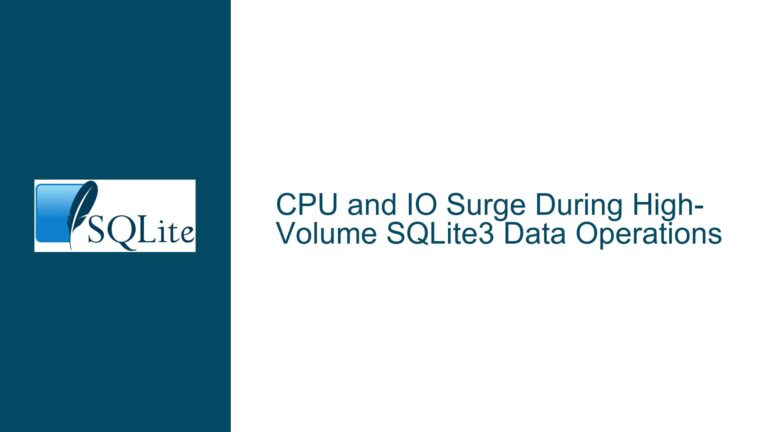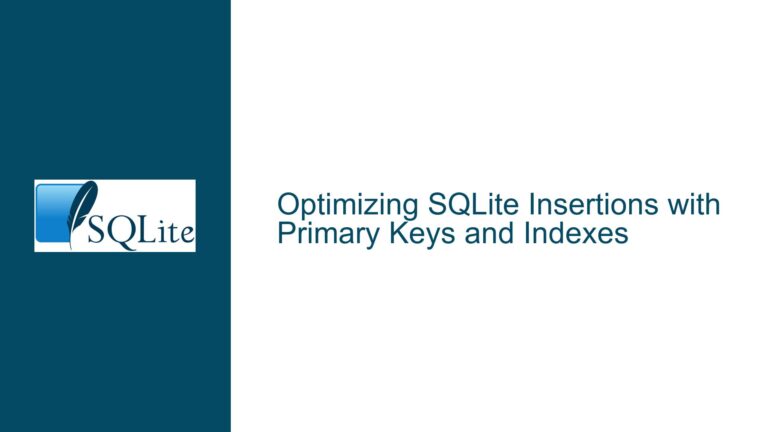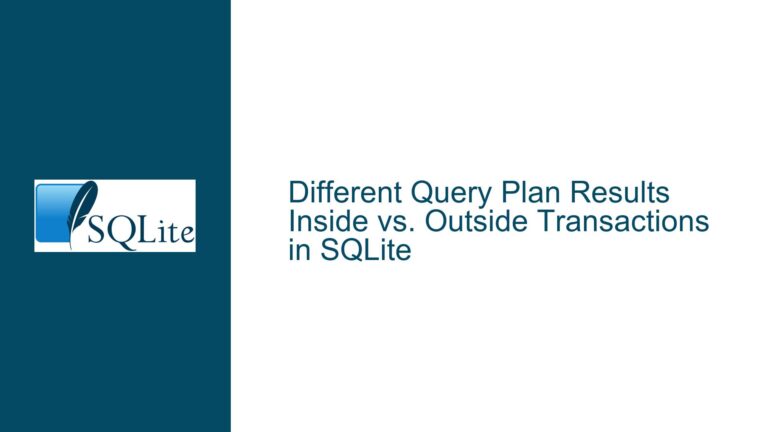Manual Checkpoint Fails in WAL Mode Without Prior Writes
Issue Overview: Manual Checkpoint Fails After Enabling WAL Mode Without Writing to the Database
When working with SQLite in Write-Ahead Logging (WAL) mode, a specific issue arises when attempting to perform a manual checkpoint immediately after enabling WAL mode on a new database without any prior writes. The checkpoint operation, executed via sqlite3_wal_checkpoint_v2(), returns SQLITE_OK but sets the output parameters pnLog and pnCkpt to -1. This indicates that the checkpoint operation could not proceed, either due to an error or because the database is not in WAL mode. However, the database is indeed in WAL mode, as confirmed by the PRAGMA journal_mode=WAL; statement.
The issue manifests under the following conditions:
- A new database is created, and a single connection is opened to it.
- WAL mode is enabled on this connection using
PRAGMA journal_mode=WAL;. - A manual checkpoint is attempted using
sqlite3_wal_checkpoint_v2()without any prior writes to the database.
The checkpoint operation fails with pnLog and pnCkpt set to -1. Interestingly, if a write operation is performed on the same connection before the checkpoint, or if the database is reopened, the checkpoint succeeds. This behavior suggests that the WAL file is not fully initialized or recognized until a transaction is committed or the database is reopened.
The root cause lies in the internal mechanics of SQLite’s WAL mode implementation. When WAL mode is enabled via PRAGMA journal_mode=WAL;, the WAL file is not immediately created. Instead, its creation is deferred until the start of the next transaction. If a checkpoint is attempted before this deferred creation occurs, the checkpoint operation fails because the WAL file does not yet exist. This behavior is not a bug but rather a consequence of SQLite’s transactional design and performance optimizations.
Possible Causes: Deferred WAL File Creation and Transactional Constraints
The failure of the manual checkpoint operation in this scenario can be attributed to two interrelated factors: the deferred creation of the WAL file and the transactional constraints of SQLite’s WAL mode.
Deferred WAL File Creation
When WAL mode is enabled using PRAGMA journal_mode=WAL;, SQLite does not immediately create the WAL file. Instead, the creation of the WAL file is deferred until the start of the next transaction. This deferral is a performance optimization, as creating the WAL file prematurely would incur unnecessary overhead if no subsequent writes occur. However, this optimization introduces a subtle edge case: if a checkpoint is attempted before the WAL file is created, the checkpoint operation fails because it has no WAL file to process.
Transactional Constraints
SQLite’s WAL mode is tightly coupled with its transactional model. The WAL file can only be created or modified within the context of a transaction. When PRAGMA journal_mode=WAL; is executed, it operates within a transaction that is in rollback mode. This means that the WAL file cannot be created during the execution of the PRAGMA statement itself. Instead, the creation of the WAL file must wait until the start of the next transaction.
The manual checkpoint operation, sqlite3_wal_checkpoint_v2(), is also constrained by SQLite’s transactional model. It cannot create or open the WAL file on its own; it can only operate on an existing WAL file. If the WAL file has not yet been created due to the deferred creation mechanism, the checkpoint operation fails.
Interaction Between Connections
While the original issue occurs with a single connection, it is worth noting that the behavior of WAL mode can be further complicated by multiple connections. WAL mode is a property of the database file, not the connection. If multiple connections are open when WAL mode is enabled, the operation may fail due to conflicts between connections. However, in this specific case, the issue arises even with a single connection, highlighting the deferred WAL file creation as the primary cause.
Troubleshooting Steps, Solutions & Fixes: Ensuring WAL File Initialization Before Checkpointing
To address the issue of manual checkpoint failures after enabling WAL mode without prior writes, several approaches can be taken. These solutions ensure that the WAL file is properly initialized before the checkpoint operation is attempted.
Solution 1: Perform a Write Operation Before Checkpointing
The simplest and most effective solution is to perform a write operation on the database before attempting the checkpoint. This write operation forces the creation of the WAL file, as it triggers the start of a transaction. Once the WAL file is created, the checkpoint operation can proceed successfully.
For example, the following code snippet demonstrates this approach:
sqlite3* checkpointer;
sqlite3_open("db.sqlite3", &checkpointer);
sqlite3_exec(checkpointer, "PRAGMA journal_mode=WAL;", 0, 0, 0);
sqlite3_exec(checkpointer, "PRAGMA synchronous=NORMAL;", 0, 0, 0);
sqlite3_exec(checkpointer, "PRAGMA user_version=0;", 0, 0, 0); // Write operation
int pnLog = 0;
int pnCkpt = 0;
auto resultCode = sqlite3_wal_checkpoint_v2(checkpointer, nullptr, SQLITE_CHECKPOINT_PASSIVE, &pnLog, &pnCkpt);
if (resultCode == SQLITE_OK && pnLog == -1 && pnCkpt == -1) {
assert(false);
}
In this example, the PRAGMA user_version=0; statement serves as a write operation, ensuring that the WAL file is created before the checkpoint is attempted.
Solution 2: Reopen the Database Connection
Another approach is to reopen the database connection after enabling WAL mode. Reopening the connection forces the WAL file to be initialized, as the connection re-establishes its state and recognizes the WAL mode setting. This approach is less efficient than performing a write operation but can be useful in scenarios where writes are not desirable.
For example:
sqlite3* checkpointer;
sqlite3_open("db.sqlite3", &checkpointer);
sqlite3_exec(checkpointer, "PRAGMA journal_mode=WAL;", 0, 0, 0);
sqlite3_exec(checkpointer, "PRAGMA synchronous=NORMAL;", 0, 0, 0);
sqlite3_close(checkpointer); // Close the connection
sqlite3_open("db.sqlite3", &checkpointer); // Reopen the connection
int pnLog = 0;
int pnCkpt = 0;
auto resultCode = sqlite3_wal_checkpoint_v2(checkpointer, nullptr, SQLITE_CHECKPOINT_PASSIVE, &pnLog, &pnCkpt);
if (resultCode == SQLITE_OK && pnLog == -1 && pnCkpt == -1) {
assert(false);
}
Solution 3: Use an Innocuous PRAGMA Statement to Start a Transaction
A more elegant solution, as implemented in SQLite’s trunk version, is to use an innocuous PRAGMA statement to start a transaction before performing the checkpoint. This approach ensures that the WAL file is created without requiring a write operation. For example:
sqlite3* checkpointer;
sqlite3_open("db.sqlite3", &checkpointer);
sqlite3_exec(checkpointer, "PRAGMA journal_mode=WAL;", 0, 0, 0);
sqlite3_exec(checkpointer, "PRAGMA synchronous=NORMAL;", 0, 0, 0);
sqlite3_exec(checkpointer, "PRAGMA cache_size;", 0, 0, 0); // Innocuous PRAGMA
int pnLog = 0;
int pnCkpt = 0;
auto resultCode = sqlite3_wal_checkpoint_v2(checkpointer, nullptr, SQLITE_CHECKPOINT_PASSIVE, &pnLog, &pnCkpt);
if (resultCode == SQLITE_OK && pnLog == -1 && pnCkpt == -1) {
assert(false);
}
This solution leverages SQLite’s internal mechanics to ensure that the WAL file is created before the checkpoint operation.
Solution 4: Upgrade to a Fixed Version of SQLite
If possible, upgrade to a version of SQLite that includes the fix for this issue. The fix, implemented in SQLite’s trunk version, ensures that the checkpoint operation automatically starts a transaction if the WAL file is not yet created. This eliminates the need for manual workarounds and provides a more robust solution.
Best Practices for Working with WAL Mode
To avoid similar issues when working with SQLite’s WAL mode, consider the following best practices:
- Always perform a write operation or start a transaction after enabling WAL mode to ensure that the WAL file is created.
- Avoid performing checkpoints immediately after enabling WAL mode without any intervening writes or transactions.
- Use the latest version of SQLite to benefit from bug fixes and performance improvements.
- Test your application’s behavior under different scenarios, including edge cases like enabling WAL mode on a new database without writes.
By following these solutions and best practices, you can ensure that your SQLite database operates smoothly in WAL mode and that manual checkpoints succeed as expected.
